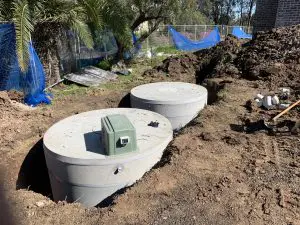What Happens When the Septic Tank is Full?
What Happens to the Waste When a Septic Tank is Full?
If you have a septic tank, you are probably wondering what happens when it becomes full. After all, you don’t want the waste to overflow and cause problems. Here’s a brief overview of what happens when a septic tank is full and what you can do to prevent it.
What is a Septic Tank?
A septic tank is a type of on-site sewage treatment system. It is typically used in areas where there is no access to a centralised sewage treatment plant. A septic tank is a buried, watertight container that receives and stores wastewater from a home or business. It is designed to allow solids to settle to the bottom of the tank, while the liquid is filtered and treated by bacteria in the tank.
How Does a Septic Tank Work?
A septic tank is connected to the home or business by a pipe called an inlet. When wastewater enters the tank, it begins to separate into three layers:
- Solids: These settle to the bottom of the tank and form a sludge layer.
- Scum: This is a layer of oil, grease, and other lighter materials that floats to the top of the tank.
- Effluent: This is the liquid layer that is in between the sludge and scum layers. It is partially treated by the bacteria in the tank.
As the wastewater is processed in the septic tank, the solids and scum layers are broken down by the bacteria. The effluent is then filtered through the soil, where it is further treated by bacteria and other microorganisms. The water is then returned to the groundwater supply.
What Happens When a Septic Tank is Full?
When a septic tank is full, it can no longer process the wastewater. This can lead to a number of problems, including:
- Overflow: If the septic tank becomes too full, the wastewater can overflow and cause a mess. This can be a health hazard, as the wastewater may contain harmful bacteria and other contaminants.
- Backups: If the septic tank is full, it can cause sewage backups in the home or business. This can be a major inconvenience and may require costly repairs.
- Damage to the drain field: The drain field is the area where the effluent is filtered through the soil. If the septic tank is full, the excess wastewater can damage the drain field, which can be costly to repair.
Preventing a Septic Tank from Becoming Full
The best way to prevent a septic tank from becoming full is to have it pumped on a regular basis. How often the septic tank needs to be pumped depends on several factors, including the size of the tank, the number of people living in the home or business, and the amount of wastewater generated. A septic service provider can help you determine the appropriate pumping.
Contact us today for a fast quote at 1800 808 135 or visit us at www.ecoseptic.com.au.
We cover all Sydney suburbs as well as the regions of South Coast, Snowy Mountains, Southern Highlands, Riverina, Blue Mountains and Hawkesbury, Laguna, North and Mid North Coast, Bateman’s Bay, Nowra, Mallacoota, Narooma, Balmoral, Cobargo, Glenn Ines, Avondale, Glenmore, Mogo, Tarago, Torrumbarry, Albury, Faulconbridge, Maraylya, Sherbrooke, Strathdickie, Little Hartley, Linden, cattail, Bowen Mountain, Murwillumbah, Kyogle, Bryon Bay, Lismore, Evan Heads, Yamba, Grafton and surrounding areas.
Related Posts
- If Your House Has A Septic Tank, Do You Have To Pay A Sewer Bill?
- How Much Sewage Is Produced Per Person?
- All You Need to Know About Septic Tanks in Sydney
- What Are Domestic Wastewater Treatment Plants?
- The Various Uses of Treated Wastewater
- Beyond the Tank: Unlocking the Potential of Treated Septic Water in Australia
- Understanding Septic Tanks: A Comprehensive Guide for Consumers
- Maxi Series Range




